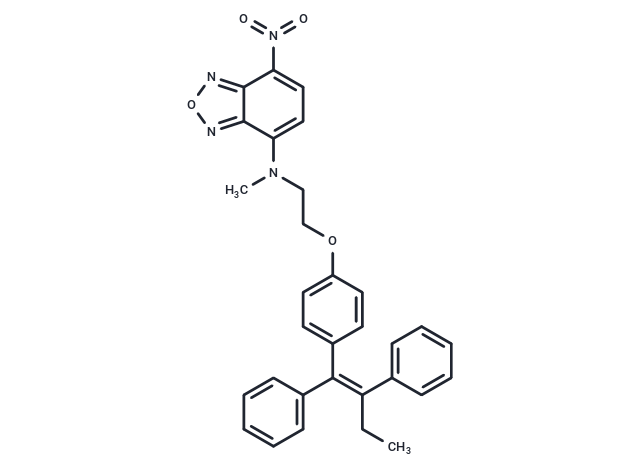Shopping Cart
- Remove All
 Your shopping cart is currently empty
Your shopping cart is currently empty

FLTX1 is a fluorescent derivative of Tamoxifen, designed to efficiently target and label intracellular Tamoxifen-binding sites (estrogen receptors) both under permeabilized and non-permeabilized conditions. Additionally, FLTX1 demonstrates strong antiestrogenic activity in breast cancer cells, resembling the potent antiestrogenic properties of Tamoxifen. Notably, FLTX1 does not exhibit any estrogenic agonistic effect on the uterus.

| Pack Size | Price | Availability | Quantity |
|---|---|---|---|
| 1 mg | $53 | In Stock | |
| 5 mg | $128 | In Stock | |
| 10 mg | $203 | In Stock | |
| 25 mg | $347 | In Stock | |
| 50 mg | $491 | In Stock | |
| 100 mg | $696 | In Stock | |
| 200 mg | $938 | In Stock |
| Description | FLTX1 is a fluorescent derivative of Tamoxifen, designed to efficiently target and label intracellular Tamoxifen-binding sites (estrogen receptors) both under permeabilized and non-permeabilized conditions. Additionally, FLTX1 demonstrates strong antiestrogenic activity in breast cancer cells, resembling the potent antiestrogenic properties of Tamoxifen. Notably, FLTX1 does not exhibit any estrogenic agonistic effect on the uterus. |
| Targets&IC50 | ERα:87.5 nM |
| In vitro | Competition studies showed that FLTX1 binding was totally displaced by unlabeled tamoxifen and partially by estradiol, indicating the existence of non-ER-related triphenylethylene-binding sites.?Ligand binding assays showed that FLTX1 exhibits similar affinity for ER than tamoxifen.?FLTX1 exhibited antiestrogenic activity comparable to tamoxifen in MCF7 and T47D cells transfected with 3xERE-luciferase reporter.?FLTX1 lacked the strong agonistic effect of tamoxifen on ERα-dependent transcriptional activity[1]. |
| In vivo | In vivo assays in mice revealed that unlike tamoxifen, FLTX1 was devoid of estrogenic uterotrophic effects, lacked of hyperplasic and hypertrophic effects, and failed to alter basal proliferating cell nuclear antigen immunoreactivity.?In the rat uterine model of estrogenicity/antiestrogenicity, FLTX1 displayed antagonistic activity comparable to tamoxifen at lower doses, and only estrogenic uterotrophy at the highest dose[2]. |
| Molecular Weight | 520.58 |
| Formula | C31H28N4O4 |
| Cas No. | 1481401-71-1 |
| Smiles | C(=C(/CC)\C1=CC=CC=C1)(\C2=CC=C(OCCN(C)C=3C=4C(C(N(=O)=O)=CC3)=NON4)C=C2)/C5=CC=CC=C5 |
| Relative Density. | 1.258 g/cm3 (Predicted) |
| Storage | Powder: -20°C for 3 years | In solvent: -80°C for 1 year | Shipping with blue ice. | ||||||||||||||||||||
| Solubility Information | DMSO: 5.21 mg/mL (10 mM), Sonication is recommended. | ||||||||||||||||||||
Solution Preparation Table | |||||||||||||||||||||
DMSO
| |||||||||||||||||||||

Copyright © 2015-2025 TargetMol Chemicals Inc. All Rights Reserved.